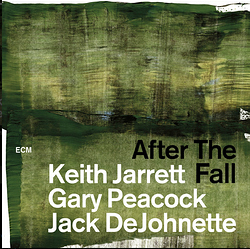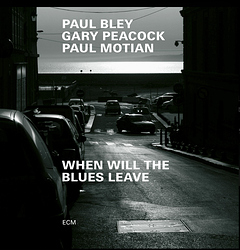Gary Peacock, Master Jazz Bassist, Is Dead at 85
He was a free-jazz pioneer early on before becoming part of Keith Jarrett’s enduring trio, where he infused American standards with a Zen sensibility.
Sept. 9, 2020

Gary Peacock playing alongside the drummer Paul Motian in a club performance in Manhattan in 2007. He brought to his music a sensibility steeped in Zen Buddhism.Michelle V. Agins/The New York Times
Gary Peacock, an upright bassist whose fastidious but open-minded style carried him through a diverse career in jazz, culminating in a three-decade run with the pianist Keith Jarrett’s Standards Trio, died on Friday at his home in Olivebridge, N.Y. He was 85.
The pianist Marilyn Crispell, a longtime collaborator, confirmed the death but did not give a cause.
Mr. Peacock earned a permanent place in the pantheon of free-jazz pioneers in the 1960s thanks largely to his partnerships with the pianist Paul Bley and the saxophonist Albert Ayler. As a member of Ayler’s various bands, he recorded, among other albums, the now-classic “Ghosts” (1964), “Spiritual Unity” (1965) and “New York Eye and Ear Control” (1965), blending the unbounded expressions of Black postmodernism — à la Ornette Coleman and Cecil Taylor — with the vocal melodicism of gospel.
Mr. Peacock spent a short but equally formative stint in the mid-1960s with the eminent pianist Bill Evans’s trio. There he picked up on the innovations of his predecessor, the bassist Scott LaFaro, who had died in a car crash in 1961 at age 25 after making a series of landmark recordings with Evans.
Like LaFaro before him, Mr. Peacock treated the bass as hallowed ground to be endlessly explored — sounding cool, low tones; scampering up the neck in cross-stroking patterns; occasionally injecting a dose of deep harmony.
He was most known in his later career as part of Mr. Jarrett’s Standards Trio, completed by the drummer Jack DeJohnette. The group had one mission: coaxing often extravagant amounts of beauty out of the Great American Songbook. In a 2007 interview with the website All About Jazz, Mr. Peacock said the band’s music was “like flowers.”
“The idea is to really nourish them,” he said, explaining how the trio handled each song. “You wouldn’t trample them; you wouldn’t give them too much water, or you’d drown them. How do I nourish these flowers so they can really express themselves?”
The trio’s reverence for its material fell into step with Mr. Peacock’s explorations of Zen philosophy, which he studied while living in Japan in the 1970s.
“The question is, How much are you willing to give up to play this music?” he told All About Jazz. “I don’t think it can work if you still have an agenda, if you feel you still need to prove something musically. That’s not the point — it’s just about the music. So you’re going to serve that, not yourself or somebody in the audience, not the critics or the reviewers. It’s just the music.”

Mr. Peacock, left, with his fellow members of the Standards Trio, the drummer Jack DeJohnette, center, and the pianist Keith Jarrett, during a performance in Paris in 2001.David Redfern/Redferns, via Getty Images
Gary George Peacock was born on May 12, 1935, in Burley, Idaho, in the southern part of the state, and grew up in various places in the Northwest. His father, Edgar, worked as a business consultant for grocery stores, and his mother, Laura (Connor) Peacock, worked at a variety of jobs.
Mr. Peacock’s first instrument was the piano, which he played in high school in Yakima, Wash., and studied at the Westlake College of Music in Los Angeles. He turned to the bass while he was a pianist in an Army band stationed in West Germany in the mid-1950s. When the bassist quit, he took over that chair and immediately fell in love with the instrument, making it his main one.
He returned to Los Angeles after his military service and became active in the music scene there, playing with the Brazilian guitarist Laurindo Almeida, the jazz guitarist Barney Kessel and the vibraphonist Terry Gibbs, among others.
In the early 1960s he married Annette Coleman, a vocalist and composer whose own explorations in music and spirituality ran alongside his. The marriage was brief, and after they separated, she left for New York and became involved with Paul Bley, although she kept Mr. Peacock’s last name. When Mr. Peacock arrived in New York in the mid-’60s, he became a close collaborator with the couple.
Together the three helped cast the mold for the distinctive sound of the ECM record label: influenced by Romantic piano music and existentialist philosophy, with a stark focus on melody. The third album released by ECM was “Paul Bley With Gary Peacock” (1970), featuring compositions by all three.
Mr. Peacock and his second wife, Nancy (Brown) Peacock, had three sons, Eliott, Collin and Niles. They all survive him, as does a sister, Patty Robbins, and two grandchildren. His second marriage also ended in divorce.
During the 1960s Mr. Peacock also played with Tony Williams, the wunderkind drummer, appearing on his debut album, “Life Time” (1964). Based on Williams’s recommendation, he substituted for Ron Carter for two months in Miles Davis’s famed quintet of the mid-’60s, in which Williams played drums.
Mr. Peacock spent two years in Japan in the late 1960s and early '70s, studying Zen Buddhism and Eastern philosophy and playing with musicians there. He released his first two albums as a leader during this time, for the Japanese CBS/Sony label. The releases, “Eastward” (1970) and “Voices” (1971), featured the pianist Masabumi Kikuchi, who would become a lifelong collaborator, as well as the drummer Hiroshi Murakami.
Mr. Peacock returned to the United States in 1972 and enrolled as a biology student at the University of Washington, receiving his bachelor’s degree in 1976. The next year he released “Tales of Another,” a collection of six spare originals. The album, his first for ECM as a leader, was also the first recording to feature him alongside Mr. Jarrett and Mr. DeJohnette. The trio bonded immediately.

Mr. Peacock performing with Mr. Jarrett and Mr. DeJohnette at Carnegie Hall in 2010.Joshua Bright for The New York Times
“One of the first things I heard when we started playing together was the depth,” Mr. Peacock told JazzTimes in 2008. “There were three individuals, but there was one mind expressing itself. We knew that there was something very special there.”
He continued to compose and perform as a bandleader throughout the rest of his career, with, among others, Ms. Crispell, the guitarist Ralph Towner and a trio featuring the pianist Marc Copland and the drummer Joey Baron. Toward the end of his life, he completed the manuscript for a memoir, which remains unpublished.
While he lived for music, Mr. Peacock valued its opposite equally. “Where I live is very silent,” he told All About Jazz from his home, in the Catskill region of upstate New York. “I really love it. There’s no cars, no people, just the wind in the trees, a deer walking around, a cowbell, a brook. So mostly I spend a lot of time in silence.”




